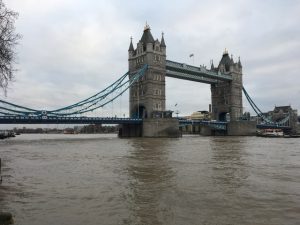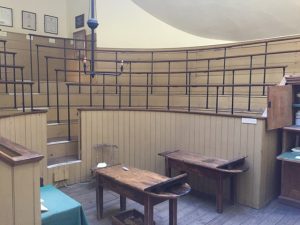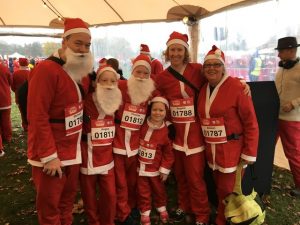Four weeks after arriving in England I am settling in to life in London. Joining the other commuters I brave the cold wind and stand at the platform busy on my mobile phone; but I’ve discovered that others are wearing special gloves with thin index and thumb pad areas so you can use your mobile phone without taking off your gloves – I need those!
I’ve found my morning coffee stop, which not only makes me feel normal with the required caffeine intake, but helps the homeless. It’s called “Change Please” and helps the homeless by turning them into Barista’s with training, support and a little van on the street corner. It’s a really good social enterprise and the coffee is excellent.

I have an Honorary Observership at Guys and St Thomas’s Hospital in London and the Breast service is based at Guys hospital just on the south side of the River Thames, next to London Bridge station. I’ve attended clinics, operating lists and multi-disciplinary meetings, just like I would in Melbourne. Many things are similar such as mammograms and pathology and breast cancer treatment in general but there are some subtle differences in practice. One difference is that GP’s cannot order breast imaging and so must refer the patients to a breast service where they will be seen and then a mammogram or ultrasound is ordered by the hospital doctors. In Australia, GP’s are encouraged to order theses tests so the diagnostic process can begin straight away. Implant reconstruction has also changed here in the last couple of years. Increasing use of acellular dermal matrix can provide coverage over the implant so that it is not always necessary to put the implant under the Pectoralis Major muscle, which is the standard method for this reconstruction.
London is a city with an incredible history and there are so many fascinating museums. While the large big museums like the British museum and the Natural History Museum are impressive, I have also found a couple of small medical museums. The Florence Nightingale Museum (next to St Thomas’ hospital) gives an insight into the life and achievements of an amazing woman. She not only performed nursing duties but worked to reform hospitals and their management in order to improve patient care. Across the road from Guy’s hospital, I found an astonishing little museum up the spiral staircase of a bell tower in the attic of a church.
 This is the Old Operating Theatre Museum. It was surreal to stand in an operating theatre from 1822, and imagine operating on a (maybe anaesthetised) patient without gloves and sterile equipment, in front of a large audience standing in a stalls looking down. This operating theatre was opened to provide a place for female patients to have surgery so they did not have to have their surgery on the ward. I am certainly pleased we have progressed so far in the practice of surgery!
This is the Old Operating Theatre Museum. It was surreal to stand in an operating theatre from 1822, and imagine operating on a (maybe anaesthetised) patient without gloves and sterile equipment, in front of a large audience standing in a stalls looking down. This operating theatre was opened to provide a place for female patients to have surgery so they did not have to have their surgery on the ward. I am certainly pleased we have progressed so far in the practice of surgery!
 Having also survived the Great Ormond Street Hospital Santa Dash (fun run in a Santa outfit), I’m off to an Oncoplastic Conference in Milan next week; only a short flight of less than 2 hours from London.
Having also survived the Great Ormond Street Hospital Santa Dash (fun run in a Santa outfit), I’m off to an Oncoplastic Conference in Milan next week; only a short flight of less than 2 hours from London.
Dr Sophie Nightingale. Sabbatical leave from November 2017 - January 2018.

